 |
 |
 |
 |
Technology Roadmap: Nuclear Energy - 2015 Edition
International Energy Agency (IEA), Nuclear Energy Agency (NEA), 2015, 60 p.
Since the release in 2010 of Technology Roadmap: Nuclear Energy (IEA/NEA, 2010), a number of events have had a significant impact on the global energy sector and on the outlook for nuclear energy. They include the Fukushima Daiichi nuclear power plant (NPP) accident in March 2011, the global financial and economic crises that hit many industrialised countries during the period 2008-10 and failings in both
|
electricity and CO2 markets. Despite these additional challenges, nuclear energy still remains a proven low-carbon source of base-load electricity, and many countries have reaffirmed the importance of nuclear energy within their countries’ energy strategies.
To achieve the goal of limiting global temperature increases to just 2 degrees Celsius (°C) by the end of the century, a halving of global energy-related emissions by 2050 will be needed. A wide range of low-carbon energy technologies will be needed to support this transition, including nuclear energy.
This edition of the nuclear roadmap prepared jointly by the IEA and NEA take into account recent challenges facing the development of this technology. The 2015 edition of the Nuclear Energy Technology Roadmap aims to:
- Outline the current status of nuclear technology development and the need for additional R&D to address increased safety requirements and improved economics.
- Provide an updated vision of the role that nuclear energy could play in a low-carbon energy system, taking into account changes in nuclear policy in various countries, as well as the current economics of nuclear and other low-carbon electricity technologies.
- Identify barriers and actions needed to accelerate the development of nuclear technologies to meet the Roadmap vision.
- Share lessons learnt and good practices in nuclear safety and regulation, front- and back-end fuel cycle practices, construction, decommissioning, financing, training, capacity building and communication.
Annex: Nuclear Energy Case Studies | Foldout | News article
Extraído de:
http://www.iea.org/publications/freepublications/publication/technology-roadmap-nuclear-energy-1.html |
 |
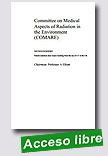 |
Patient radiation dose issues resulting from the use of CT in the UK
Committee on Medical Aspects of Radiation in the Environment (COMARE-UK), 14 August 2014, 104 p.
In this report, COMARE presents a comprehensive review of the radiation dose issues associated with CT scans in the UK. The implications of the increase in the numbers of CT scans in the UK are considered in the report, with focus on the number of younger patients undergoing CT scans, who have greater sensitivity to x-rays. The report provides an update on the radiation protection aspects of justification (balancing risk and benefit) and optimisation (balancing the risk from the radiation dose with the quality of the image). |
Extraído de:
https://www.gov.uk/government/publications/review-of-radiation-dose-issues-from-the-use-of-ct-in-the-uk
|
 |
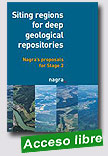 |
Siting regions for deep geological repositories - Nagra’s proposals for Stage 3
National Cooperative for the Disposal of Radioactive Waste - Nagra (Swiss), January 2015, 8 p.
The Swiss Federal Office of Energy (SFOE) has the lead in the process that regulates the search for sites for deep geological disposal of all radioactive waste arising in Switzerland. In 2008, the procedure to be followed was defined by the Federal Council (Federal Government) in the Sectoral Plan for Deep Geological Repositories. Nagra prepares siting proposals in |
each of the three stages of the process; these are reviewed by the authorities and each stage ends with a decision by the Federal Council on which siting proposals are to be carried forward to the next stage. The objective is to identify one site each for a high-level waste (HLW) repository and a low- and intermediate-level waste (L/ILW) repository or a site for a combined repository for the two waste categories. Safety always has the highest priority.
Extraído de:
http://www.nagra.ch/display.cfm/id/102106/disp_type/
display/filename/e_Faltblatt%20Einengung%202015_klein.pdf
|
 |
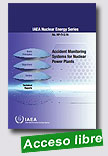 |
In the Fukushima Daiichi accident, the instrumentation provided for accident monitoring proved to be ineffective for a combination of reasons. The accident has highlighted the need to re-examine criteria for accident monitoring instrumentation. This publication covers all relevant aspects of accident monitoring in NPPs. The critical issues discussed reflect the lessons learned from the Fukushima Daiichi accident, involve accident management and accident
|
monitoring strategies for nuclear power plants, selection of plant parameters for monitoring plant status, establishment of performance, design, qualification, display, and quality assurance criteria for designated accident monitoring instrumentation, and design and implementation considerations. Technology needs and techniques for accident monitoring instrumentation are also addressed.
Extraído de:
http://www-pub.iaea.org/books/IAEABooks/10754/Accident-Monitoring-Systems-for-Nuclear-Power-Plants
|
 |
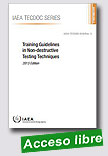 |
Training Guidelines in Non-destructive Testing Techniques - 2013 Edition
IAEA TECDOC, 2015, 286 p.
This publication is an update of IAEA TECDOC Series No. 628. Its content has been revised in light of the issuance of EN ISO 9712:2012, based on the experience of the experts as well as comments of the end user industries. The details of the topics on each subject have been expanded to include the latest developments in the respective method. The incorporated changes will assist the end-user industries to update their
|
non-destructive testing (NDT) techniques qualification and certification schemes, and course materials. This publication, like the previous version, will continue to play an important role towards international harmonization in the field of NDT training and certification.
Extraído de:
http://www-pub.iaea.org/books/IAEABooks/10765/Training-Guidelines-in-Non-destructive-Testing-Techniques-2013-Edition
|
 |
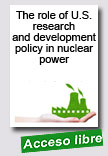
|
The Role of U.S. Research and Development Policy in Nuclear Power
R Street Institute (US), February 2015, 7 p.
The U.S. civil nuclear sector faces a number of challenges that threaten grid reliability and climate mitigation goals. Though current U.S. reactor designs improve confidence in the predictability of construction schedules and costs, the United States is unlikely to see a substantial expansion of its nuclear fleet in the near future. The biggest current obstacles are cheap shale gas and continued mandates and subsidies for |
other forms of generation, particularly renewables. State and federal agencies, including the Environmental Protection Agency, should treat nuclear power like any other non-emitting source. Furthermore, the federal government should refocus its nuclear research and development programs. Of particular value to improving the competitiveness of nuclear power would be advances that reduce operation and maintenance costs for the existing fleet and that improve the thermal efficiency and fuel burn-up of future reactors, thus reducing waste streams and significantly increasing revenue streams for owners and operators. A new fast test reactor that allows testing of advanced concepts should be built as soon as possible, to achieve these strategically important objectives.
Extraído de:
http://www.rstreet.org/policy-study/the-role-of-u-s-research-and-development-policy-in-nuclear-power
|
 |
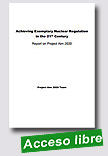 |
Achieving Exemplary Nuclear Regulation in the 21st Century
United States Nuclear Regulatory Commission, 30 January 2015, 36 p.
The NRC’s Executive Director for Operations (EDO) established Project Aim 2020 in coordination with the Chief Financial Officer (CFO) in June 2014 to enhance the agency’s ability to plan and execute its mission while adapting in a timely and effective manner to a dynamic environment. A series of developments converged in the spring of 2014 and precipitated the need for and urgency of this project. The NRC
|
achieves a high level of success in accomplishing the agency’s safety and security mission, but its effectiveness, efficiency, agility, flexibility, and performance must improve for the agency to continue to succeed in the future.
Extraído de: http://pbadupws.nrc.gov/docs/ML1502/ML15023A579.pdf
|
 |
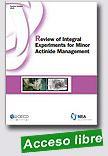 |
Review of Integral Experiments for Minor Actinide Management
Nuclear Energy Agency (NEA),2015, 142 p.
It is essential to establish a reliable fuel cycle and safely manage radioactive waste when pursuing the sustainable use of nuclear fission energy. One of the key aspects involved in realising this goal is the appropriate management of minor actinides (MAs). An effective way to manage MAs is to transmute them in nuclear systems. However, due to a lack of experimental data, which has meant an absence of precision |
in MA nuclear data, it remains difficult to establish a detailed design of transmutation systems with reliable accuracy and the capacity to precisely predict the composition of spent fuel. The NEA Nuclear Science Committee (NSC) was therefore asked to undertake a critical review of integral experiments to validate MA nuclear data with the appropriate quality assurance for MA transmutation in nuclear systems. The NSC established the Expert Group on Integral Experiments for Minor Actinide Management (EGIEMAM) in 2009.
Extraído de:
https://www.oecd-nea.org/science/pubs/2015/7222-review-minor-actinide-management.pdf
|
 |
|
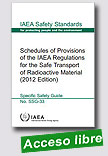
|
Schedules of Provisions of the IAEA Regulations for the Safe Transport of Radioactive Material, 2012 Edition
IAEA Safety Standards Series, 2015, 289 p.
This Safety Guide aims to aid users of radioactive material and regulators by providing a listing of relevant requirements of the regulations (IAEA Safety Standards Series No. SSR 6) as applicable to the type of radioactive material, package or shipment. Once a consignor has properly classified the radioactive material to be shipped (following the recommendations provided in Section 2 and Fig. 1 of this
|
Safety Guide), the appropriate UN number can be assigned and the paragraph numbers of specific requirements for shipment can be found in the corresponding schedule.
Extraído de:
http://www-pub.iaea.org/books/IAEABooks/10687/Schedules-of-Provisions-of-the-IAEA-Regulations-for-the-Safe-Transport-of-Radioactive-Material-2012-Edition
|
 |
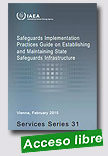 |
Safeguards Implementation Practices Guide on Establishing and Maintaining State Safeguards Infrastructure
IAEA Services Series, 2015, 130 p.
The purpose of Safeguards Implementation Practices (SIP) Guides is to share information about effective safeguards implementation practices for the benefit of all States, particularly with the aim of enhancing their capacity and capabilities in the area of safeguards implementation. States
|
with Small Quantities Protocols are advised to refer to the Safeguards Implementation Guide for States with Small Quantities Protocols (IAEA Services Series 22) found at ww.iaea.org/safeguards/resources-for-states/guidance-documents.html.
This SIP Guide addresses activities undertaken by a State to establish and maintain the infrastructure needed to implement IAEA safeguards effectively, including a legal and regulatory framework and a State authority responsible for safeguards implementation.
Extraído de: http://www-pub.iaea.org/MTCD/Publications/PDF/SVS-31_web.pdf
|
| |
| |
|
|
| |
|
|
|
| |
|
|
|
| |
|
